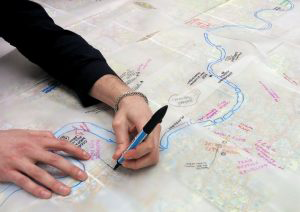Aug 6, 2018
 After completing the Foundations of Dialogue Educationourse in Vermont with Michael Culliton, Peter Perkins and Kate LaRose, Rev. Christine MacDowall kindly flew down to Raleigh to spend a week with me. Imagine!
After completing the Foundations of Dialogue Educationourse in Vermont with Michael Culliton, Peter Perkins and Kate LaRose, Rev. Christine MacDowall kindly flew down to Raleigh to spend a week with me. Imagine!
Christine had flown from Melbourne, Australia to Vermont to take the course, after having read a few of my books and realizing how dialogue in her educational practices as a pastor would be very useful to her congregation and to herself!
On my back porch we laughed, ate, told a thousand stories and worked hard. Christine wanted to apply the system she had just learned and practiced to her pastoral context. “I see a number of moving parts,” she told me. “I need to see them all working together.”
“What can I do to enable Christine to put all this together,” I wondered.
I woke one morning with the idea of TRACING – moving from the experience Christine had just had back to the principles and practices of Dialogue Education. The learning task was this:
Read aloud the first learning task Michael and Peter set for you in the course. Look at all the principles and practices cards spread out on the table. Name one of those that might have guided Michael and Peter as they composed that first learning task.
Christine immediately saw a principle she could trace the learning task back to, and then recognized there were three or more principles and practices that could have informed the designers’ decisions.
“It seems when you use one, you use them all!” She smiled at her own wise observation. “It is an iterative system!”
We went on through five or six or more learning tasks from her experience in the course, tracing each back to principles and practices: sequence, engagement, small group work, reflection, praxis… “Aha!” she said, “I see.”
How can you use tracing to check your design work or maximize impact?
*****
Dr. Jane Vella is a celebrated author, educator and founder of Global Learning Partners.



